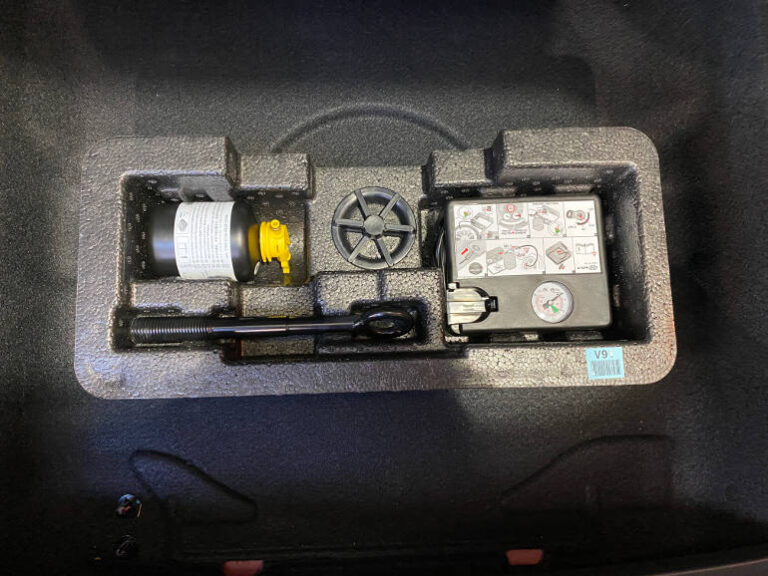Many modern cars, and almost all electric vehicles, come with a tyre repair kit as a standard accessory rather than a traditional spare tyre. These kits are essentially a combination of a sealant and a compressor to temporarily repair and reinflate a punctured tyre. But why have they become so popular with car manufacturers, and what does it mean for fleet drivers? Let’s delve into the benefits and downsides of this trend.
Benefits of tyre inflation kits
- Weight Reduction: Traditional spare tyres, especially full-sized ones, add significant weight to a vehicle. By replacing the spare with a lightweight inflation kit, manufacturers can reduce the car’s overall weight, leading to improved fuel efficiency and performance (or increased range for an EV).
- Space Savings: A spare tyre takes up considerable space in the boot, especially in smaller cars where boot space is already at a premium. By removing the spare, manufacturers can provide more usable storage space or increase the room for rear passengers.
- Cost Reduction: The cost of producing a full spare tyre, along with its accompanying tools and housing, is higher than that of a simple inflation kit. For manufacturers, especially those producing large volumes of vehicles, the cost savings can be substantial.
- Improved Fuel Efficiency: Reduced weight from the absence of a spare tyre can lead to better fuel economy, meeting stricter emission standards and appealing to environmentally-conscious consumers. For electric vehicles, increasing range is key and weight reduction is an important factor to achieve a longer driving range.
- Ease of Use: For many, the process of changing a tyre can be daunting. A tyre inflation kit provides a simpler solution that doesn’t require jacking up the vehicle or handling a heavy tyre.
Downsides for fleet frivers
- Temporary Solution: Tyre inflation kits are meant for temporary fixes, allowing the driver to reach a nearby service station or garage. They are not permanent solutions, and driving long distances, or at high speeds, after using an inflation kit can be unsafe. Drivers may not be aware of these constraints and continue driving as normal long after the tyre has been repaired.
- Limited Damage Repair: These kits are designed to seal small punctures in the tread area. They aren’t suitable for larger punctures, sidewall damage, or tyre blowouts. Fleet drivers who encounter such damages will still be stranded.
- Potential Mess: The sealant in some kits can be messy and might make it difficult for a tyre technician to carry out a proper repair or replacement later on. In some cases, once the sealant is used, the tyre may need to be replaced rather than repaired.
- Cost Implications: While the upfront cost for manufacturers might be less, fleet drivers or companies might find themselves replacing tyres more often after using a sealant, which can be more expensive in the long run.
- Lack of a Full Spare: In areas or situations where immediate professional tyre repair services aren’t accessible, not having a full spare can be a major disadvantage. Fleet drivers on tight schedules might find this particularly problematic.
- Training Required: Fleet drivers need to be familiar with how to use the inflation kit properly. Incorrect usage can lead to ineffective sealing or further damage to the tyre.
The decision by car manufacturers to include tyre inflation kits as opposed to traditional spare tyres in vehicles is driven by factors like cost, space-saving, weight reduction, and consumer ease. For the average commuter, these benefits might outweigh the downsides, especially if they primarily drive in urban environments with easy access to repair services.
However, for fleet drivers who might be on the road for extended periods, covering long distances, and possibly venturing into areas where immediate tyre repair services are sparse, the lack of a traditional spare can pose challenges. The effectiveness and suitability of tyre inflation kits largely depend on the nature of the fleet operations and the regions they cover.
It’s essential for fleet managers to evaluate the pros and cons based on their unique needs. If tyre inflation kits are part of their fleet vehicles, providing drivers with the necessary training and understanding of the kits’ limitations becomes crucial.






